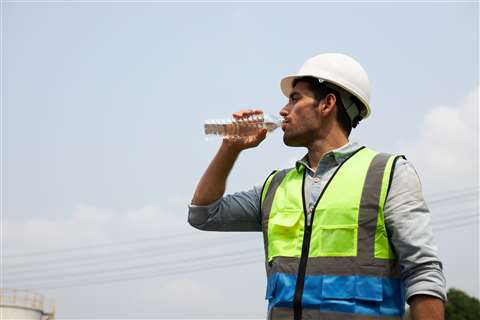Skin cancer among construction workers: The risks and how to mitigate them
05 May 2023
 Image: Cheangchai via AdobeStock - stock.adobe.com
Image: Cheangchai via AdobeStock - stock.adobe.com
There is little doubt that site-based construction workers are at greater risk of skin cancer than many other professions.
That’s because the outdoor nature of their work means that they are exposed to higher levels of ultraviolet radiation.
May is Skin Cancer Awareness Month and it comes at a time of year when as temperatures in the northern hemisphere start to warm up and construction site workers’ exposure to UV radiation starts to increase.
A recent study in Canada found that cases of work-related non-melanoma skin cancer among construction workers in Ontario are on track to double by 2060.
A 2019 study in Scotland by Heriot-Watt University and the Institute of Occupational Medicine (IoSH) in Edinburgh found that almost half of outdoor workers on construction sites had insufficient vitamin D in winter. But many then deliberately exposed themselves to UV radiation in the summer, raising their risk of developing non-melanoma skin cancer.
In Germany, skin cancer was reported to be the number one occupational disease in construction in 2020, with employees in civil engineering and road construction particularly affected.
And in the US, where nearly five million people are treated for skin cancer each year, a study of 2,298 agricultural and construction workers found that the use of sunscreen and shade seeking behaviour was low.
It found that among construction workers, only 15.1%-21.4% used sunscreen, depending on age group and other factors, while 24.5%-29.1% sought shade and only 50.7% wore any protective clothing.
Measures are simple...but workers don’t always adopt them
The US study identified five simple protective behaviours that construction workers could use to lower their risk of developing skin cancer:
- Moving into the shade wherever possible.
- Using sunscreen with a sun protection factor of at least SPF15 (some dermatologists recommend that it should be at least SPF30)
- Wearing a wide-brimmed hat.
- Wearing a long-sleeved shirt.
- Wearing long trousers (pants) or other clothing that reaches to the ankles.
But it found that while most construction workers reported regularly using at least one method of sun protect (66.6%), regular use of multiple methods was low.
And it’s here that perhaps the problem lies: Construction workers are likely to be aware of at least some of the measures they can take. But encouraging them to take those precautions proves to be harder and employers have an important role to play.
 OSHA is seeking submissions for a new campaign aimed at combatting heat-related work problems. (Photo: Adobe Stock)
OSHA is seeking submissions for a new campaign aimed at combatting heat-related work problems. (Photo: Adobe Stock)
The Heriot-Watt study found that the perception among workers was that a suntan was “healthy”.
But after fitting workers on nine sites in central Scotland and in London with a wearable UV sensor mounted to their hard hat, researchers found that the dose of UV radiation the workers were receiving was anything but.
They measured UV exposure through standard erythemal dose (SED). The International Commission on Non-ionising Radiation recommends a limit on daily exposure for a person with light-coloured skin to 0.3 SED per day. Above 2 SED in a day creates a risk of sunburn.
During the summer, workers who predominantly worked outdoors received an average of 2 SED per day. Even those who worked partly indoors and partly outdoors received 0.69 SED.
Separate studies among road construction workers in Poland and New Zealand found daily irradiation levels of 11.5 SED in July and 5.3 SED in January respectively.
Researchers have warned that such levels over a working lifetime could significantly increase the risk of non-melanoma skin cancer.
Employers can ‘nudge’ employees to safer practices
But short messages about the risks did not influence workers to take protective measures, the Heriot-Watt study found.
IoSH made a series of recommendations to employers to “nudge” workers towards better behaviours. They included:
- Health promotion initiatives to make healthier dietary choices, including dietary supplements over winter to boost vitamin D levels.
- A risk-based approach to managing exposure to solar UV, in which risk management measures should be prescribed and the use of those measures enforced.
- Health surveillance to detect skin cancer among outdoor workers.
- Nudging messages via text messages or location-driven apps to help workers stay safe in the sun.
Meanwhile, experts have also suggested that employers can schedule work outside the hours when UV rays are most intensive (typically 10am to 4pm) where possible.
Canada’s Institute for Work and Health suggested that if employees who work outdoors adopted protective equipment and clothing such as long-sleeve shirts, pants and neck coverings, then it could reduce the number of work-related skin cancers by 6,034 over three decades in Ontario alone.
More advice and resources:
https://www.hse.gov.uk/construction/healthrisks/cancer-and-construction/skin-cancers.htm
https://www.osha.gov/sites/default/files/publications/osha3166.pdf
https://www.sunsmart.com.au/advice-for/workplaces/outdoor-workplaces/construction-workers
STAY CONNECTED



Receive the information you need when you need it through our world-leading magazines, newsletters and daily briefings.
CONNECT WITH THE TEAM








